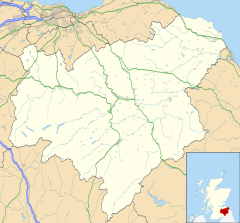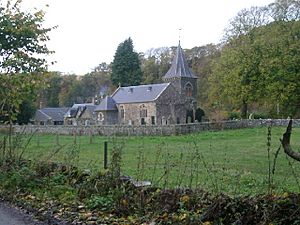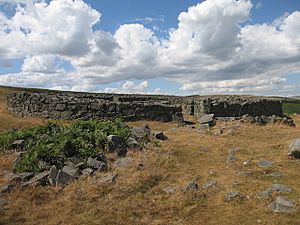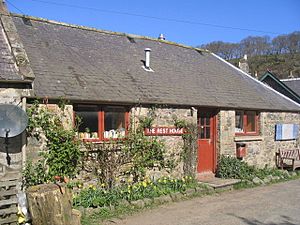Abbey St Bathans facts for kids
Quick facts for kids Abbey St Bathans
|
|
|---|---|
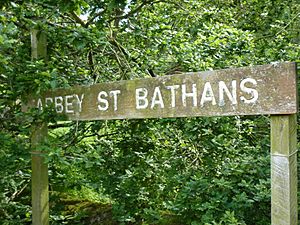 Abbey St Bathans sign in the centre of the village |
|
| Population | 106 (2011) |
| OS grid reference | NT762618 |
| Council area | |
| Lieutenancy area | |
| Country | Scotland |
| Sovereign state | United Kingdom |
| Post town | DUNS |
| Postcode district | TD11 |
| Police | Lothian and Borders |
| Fire | Lothian and Borders |
| Ambulance | Scottish |
| EU Parliament | Scotland |
| UK Parliament |
|
| Scottish Parliament | |
Abbey St Bathans (Scottish Gaelic: Abaid Bhaoithin) is a small village in Scotland. It is found in the Scottish Borders area, in a beautiful, winding valley. The Whiteadder Water river flows through this valley. In 2011, only about 106 people lived in Abbey St Bathans.
Contents
A Look Back: History and the Kirk
The Old Priory
Long ago, in the 1100s, Abbey St Bathans was home to a priory. A priory was a type of religious house, like a monastery. This one was for Cistercian Nuns, who were religious women. They used it as a quiet place to retreat and pray.
The exact spot of the old priory is not known today. However, there is a special stone called the Abbey Stone nearby. Even though the priory is gone, there is still a small church in the village square. It is sometimes called a "Kirk" in Scotland.
The Village Church
The current church in Abbey St Bathans was rebuilt in the 1700s. It uses some parts of the original priory church walls from the late 1300s. This first church was dedicated to St Mary.
In the 1960s, some old pottery pieces were found near the church. Experts from the Royal Scottish Museum said these pieces were from the Middle Ages. This suggests that the old priory might have been located near the current church, by the river.
Saint Bathan and Ancient Times
The church is dedicated to Saint Bathan (Scottish Gaelic: Baithéne mac Brénaind). He was an important religious leader, the second abbot of Iona.
People have lived in the Abbey St Bathans area for a very long time. About 2,500 years ago, during the Bronze Age, people lived here. A Bronze Age dagger was found, showing this. There is also a nearby place called Edin's Hall Broch. This was an Iron Age fort, built to defend people.
Exploring the Village
Abbey St Bathans village is right next to the Whiteadder Water river. The main part of the village has the church, a footbridge, and some houses. The footbridge is known as the 'Gurkha bridge'. Gurkha soldiers helped build it in 1987.
If you go further up the valley, you'll find the village hall. It hosts events and sometimes shows art. Downriver from the church, there's a fish farm, a car park, a café, and a small sawmill.
Walking and Cycling
Abbey St Bathans is a great place for outdoor activities. Two famous walking paths, the Southern Upland Way and the Sir Walter Scott Way, go through the village. There are also other paths for walkers. You can hike to the nearby Edin's Hall Broch or to Cockburn Law hill. The village is also on a popular route for cyclists.
Years ago, there was a youth hostel in the village called the Rest House. It offered a place for young travelers to stay, but it has been closed for over ten years now.
A Name Across the World
Did you know that a town in New Zealand is named after this small Scottish village? The township of Saint Bathans in New Zealand got its name from Abbey St Bathans.
Abbey St Bathans House
Abbey St Bathans House is a large building in the area. It likely started as a smaller, pretty cottage in the early 1800s. It was built for the Turnbull family. Over the years, especially in the 1870s, the house was made much bigger. It has many interesting features like fancy chimneys and different roof styles.
Inside, the house has attractive rooms, especially the staircase. Many of the decorations and fittings were moved here in the 1880s from another house called Bassendean House.
On the estate around the house, there are other buildings. These include a lodge, stables, and a cottage for the groom. There is also a complex of buildings for the gamekeeper and kennels for dogs. In 2019, the house was divided into several homes.
See Also


